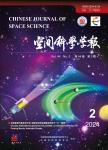MONITORING OF ENERGETIC PARTICLE ENVIRONMENT INSIDE THE CHINA-BRAZIL EARTH RESOURCE SATELLITE
MONITORING OF ENERGETIC PARTICLE ENVIRONMENT INSIDE THE CHINA-BRAZIL EARTH RESOURCE SATELLITE作者机构:Department of Geophysics Peking University Beijing 100871 P.R. China Department of Geophysics Peking University Beijing 100871 P.R. China Department of Geophysics Peking University Beijing 100871 P.R. China Department of Geophysics Peking University Beijing 100871 P.R. China
出 版 物:《空间科学学报》 (Chinese Journal of Space Science)
年 卷 期:2002年第22卷第Z1期
页 面:57-63页
核心收录:
学科分类:08[工学] 0825[工学-航空宇航科学与技术]
主 题:Earth's radiation belts, Space energetic particles, Space weather
摘 要:On 14 October 1999, the Chinese-Brazil earth resource satellite (CBERS-1) was launched in China. On board of the satellite there was an instrument designed at Peking University to detect the energetic particle radiation inside the satellite so the radiation fluxes of energetic particles in the cabin can be monitored continuously. Inside a satellite cabin, radiation environment consists of ether penetrated energetic particles or secondary radiation from satellite materials due to the interactions with primary cosmic *** of the detectors are twofold, to monitor the particle radiation in the cabin and also to study the space radiation environment The data can be used to study the radiation environment and their effects on the electronics inside the satelhte cabin. On the other hand, the data are useful in study of geo-space energetic particle events such as solar proton events, particle precipitation and variations of the radiation belt since there should be some correlation between the radiation situation inside and outside the *** instrument consists of two semi-conductor detectors for protons and electrons respectively. Each detector has two channels of energy ranges. They are 0.5-2MeV and ≥2MeV for electrons and 5-30MeV and 30-60MeV for protons. Counting rate for all channels are up to 104/(cm2@s)and power consumption is about 2.5 W. There are also the additional functions of CMOS TID (total integrated dose) effect and direct SEU monitoring. The data of CBMC was first sent back on Oct. 17 1999 and it s almost three years from then on. The detector has been working normally and the quality of data is *** preliminary results of data analysis of CBMC not only reveal the effects of polar particle precipitation and radiation belt on radiation environment inside a satellite, but also show some important features of the geo-space energetic particle *** one of the most important parameters of space weather, the energetic charged particles h



